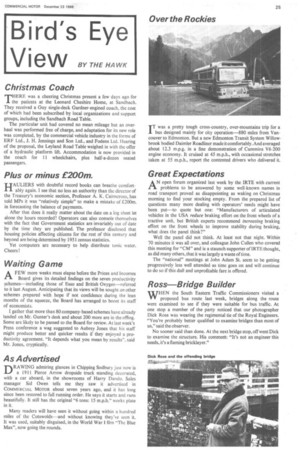Bird's Eye
Page 27

If you've noticed an error in this article please click here to report it so we can fix it.
Iv iew BY THE HAWK
Christmas Coach
THERE was a cheering Christmas present a few days ago for the patients at the Leonard Cheshire Home, at Sandbach. They received a Guy single-deck Gardner-engined coach, the cost of which had been subscribed by local organizations and support groups, including the Sandbach Road Table.
The particular unit had covered no mean mileage but an overhaul was performed free of charge, and adaptation for its new role was completed, by the commercial vehicle industry in the forms of ERF Ltd., J. H. Jennings and Son Ltd., and Fodens Ltd. Hearing of the proposal, the Leyland Road Table weighed in with the offer of a hydraulic platform lift. Accommodation is now provided in the coach for 11 wheelchairs, plus half-a-dozen seated passengers.
Plus or minus £200m.
HAULIERS with doubtful record books can breathe comfortably again. I see that no less an authority than the director of the Treasury's economic section, Professor A. K. Cairrtcross, has told MPs it was "relatively simple" to make a mistake of £200m. in forecasting the balance of payments.
After that does it really matter about the date on a log sheet let alone the hours recorded! Operators can also console themselves with the fact that Government statistics are invariably out of date by the time they are published. The professor disclosed that housing policies affecting citizens for the rest of this century and beyond are being determined by 1951 census statistics.
Yet computers are necessary to help distribute tonic water. Cheers !
Waiting Game
AFEW more weeks must elapse before the Prices and Incomes Board gives its detailed findings on the seven productivity schemes—including those of Esso and British Oxygen—referred to it last August. Anticipating that its views will be sought on other schemes prepared with hope if not confidence during the lean months of the squeeze, the Board has arranged to boost its staff of economists.
I gather that more than 80 company-based schemes have already landed on Mr. Gunter's desk and about 200 more are in the offing. Some are likely to be passed to the Board for review. At last week's Press conference a wag suggested to Aubrey Jones that his staff might produce better and quicker results if they enjoyed a productivity agreement. "It depends what you mean by results", said Mr. Jones, cryptically.
As Advertised
DRAWING admiring glances in Chipping Sodbury just now is a 1911 Pierce Arrow dropside truck standing decorated, with a car aboard, in the showrooms of Harry Dando. Sales manager Sid Owen tells me they saw it advertised in COMMERCIAL MOTOR about seven years ago, and it has long since been restored to full running order. He says it starts and runs beautifully. It still has the original "6 tons: 15 m.p.h." works plate in it.
Many readers will have seen it without going within a hundred miles of the Cotswolds—and without knowing they've seen it, It was used, suitably disguised, in the World War 1 film "The Blue Max", now going the rounds.
IT was a pretty tough cross-country, over-mountains trip for a bus designed mainly for city operation-880 miles from Vancouver to Edmonton. But a new Edmonton Transit System Willowbrook bodied Daimler Roadliner made it comfortably. And averaged about 12.3 m.p.g. in a fine demonstration of Cummins V6-200 engine economy. It cruised at 45 m.p.h., with occasional stretches taken at 55 m.p.h., report the contented drivers who delivered it.
Great Expectations
AN open forum organized last week by the IRTE with current problems to be answered by some well-known names in road transport proved as disappointing as waking on Christmas morning to find your stocking empty. From the prepared list of questions many more dealing with operators' needs might have been put—to quote but one: "Manufacturers of articulated vehicles in the USA reduce braking effort on the front wheels of a tractive unit, but British experts recommend increasing braking effort on the front wheels to improve stability during braking, what does the panel think?"
Well the panel did not think. At least not that night. Within 70 minutes it was all over, and colleague John Cullen who covered this meeting for "CM" and is a staunch supporter of1RTE thought, as did many others, that it was largely a waste of time.
The "national" meetings at John Adam St. seem to be getting progressively less well attended as time goes on and will continue to do so if this dull and unprofitable fare is offered.
Ross—Bridge Builder
WHEN the South Eastern Traffic Commissioners visited a proposed bus route last week, bridges along the route were examined to see if they were suitable for bus traffic. At one stop a member of the party noticed that our photographer Dick Ross was wearing the regimental tie of the Royal Engineers. "You're probably better qualified to examine bridges than most of us," said the observer.
No sooner said than done. At the next bridge stop, off went Dick to examine the structure. His comment: "It's not an engineer this needs, it's a flaming bricklayer."












































































